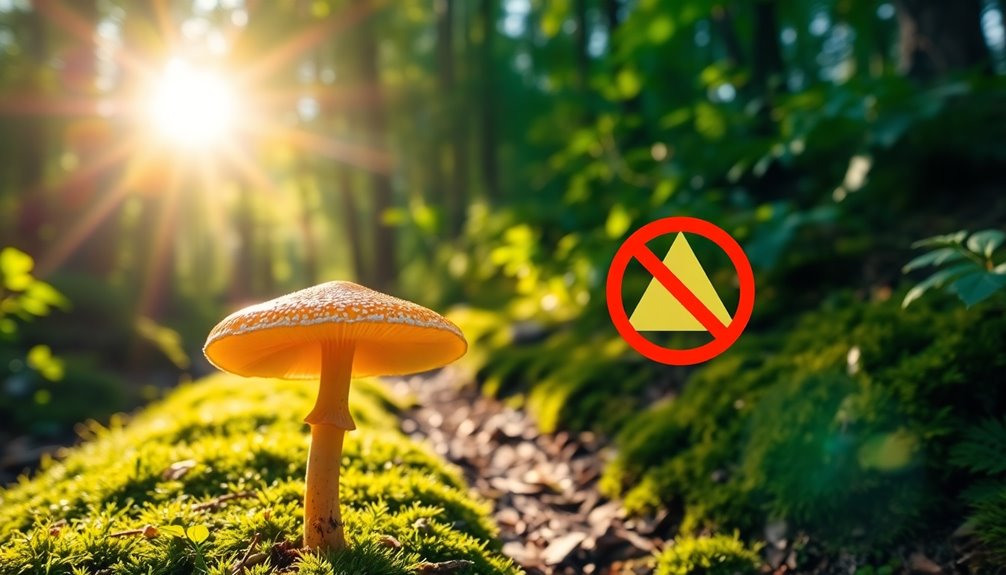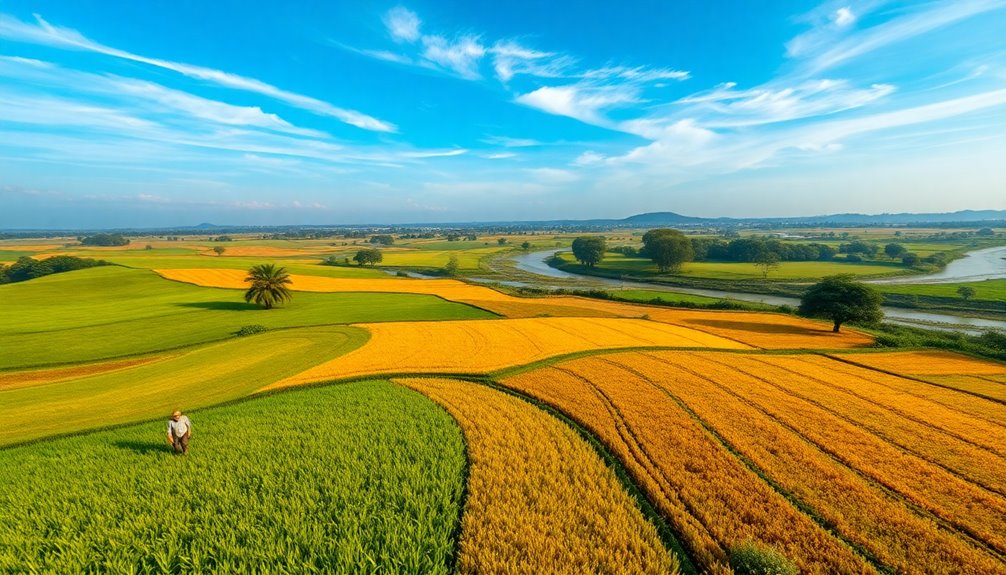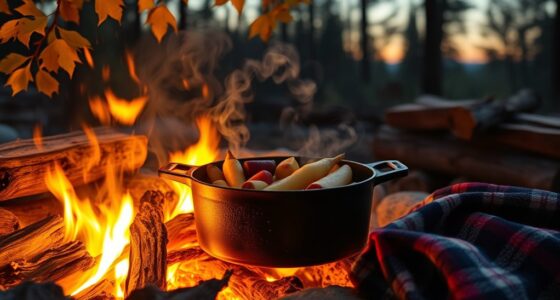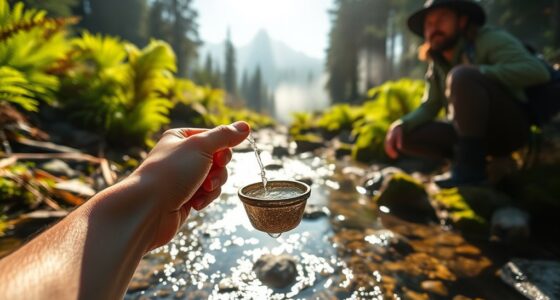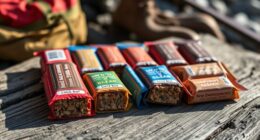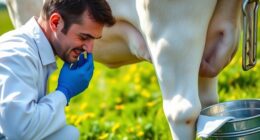When you're in the wild, staying safe from toxic substances is essential. Avoid contact with toxic plants like poison ivy and sumac, which can cause severe rashes. Be cautious of wild mushrooms; some, like the death cap, are deadly. Always wear gloves when handling plants, and wash your hands afterward to prevent accidental ingestion. Keep emergency contact numbers, like the National Poison Help Hotline (1-800-222-1222), handy in case of poisoning. Familiarizing yourself with local toxic species and learning to identify them can save your life. Discover more tips on staying safe in the wild and recognizing hazards.
Key Takeaways
- Always wear gloves and long sleeves when handling wild plants to prevent skin contact with toxins.
- Familiarize yourself with local toxic species and practice proper identification techniques, especially for mushrooms.
- Keep the National Poison Help Hotline (1-800-222-1222) and local poison control numbers easily accessible for emergencies.
- Wash hands thoroughly after handling wild plants to avoid accidental ingestion of harmful substances.
- Attend workshops and nature walks to enhance your identification skills and understand safe foraging practices.
Introduction
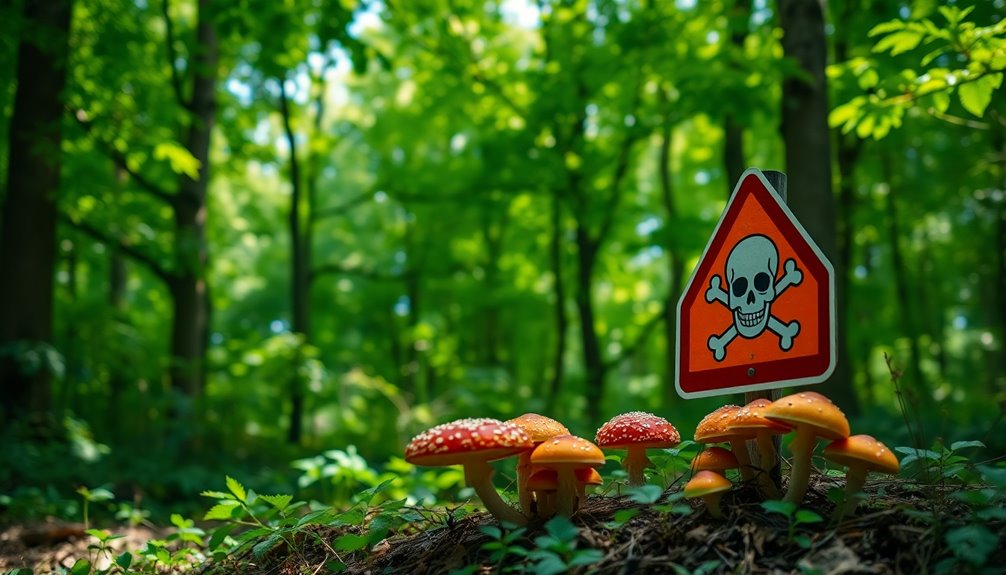
When you explore the wild, it's essential to recognize the key poison risks that lurk in nature.
Many plants and fungi can pose serious dangers, and knowing how to spot these hazards can keep you safe.
Let's take a closer look at the outdoor poison dangers you need to be aware of.
Key Poison Risks Outdoors
Outdoor adventures can be exhilarating, but they also come with hidden dangers that pose poisoning risks. Toxic plants like poison ivy and hemlock can cause severe skin reactions or respiratory issues if ingested.
Be cautious of wild mushrooms—some, like the death cap, contain potent toxins that can lead to liver failure and death. Insect stings from bees, wasps, and certain spiders can trigger allergic reactions, requiring immediate medical attention.
Additionally, chemical exposure from pesticides and herbicides can result in acute poisoning symptoms and long-term health risks. When foraging for berries, remember that pokeberries are toxic while wild blueberries are safe.
Always know your surroundings and keep the number of your local poison center handy in case of emergencies.
Highlight Outdoor Poison Dangers
Poison dangers lurk in every corner of nature, and being aware of them can be the difference between a fun adventure and a trip to the hospital.
Wild mushrooms can be highly toxic, with many mimicking safe varieties, so expert identification is essential. During spring and summer, poisonous plants like poison ivy and pokeweed thrive, increasing your risk of exposure.
If you forage for wild plants, you need to know about toxic look-alikes. Additionally, outdoor chemicals like pesticides and herbicides pose serious poisoning risks if ingested or absorbed through your skin.
Even substances like antifreeze and windshield washer fluid can be fatal if consumed, even in small amounts.
For immediate guidance, remember to reach out to Poison Help. Stay vigilant!
Toxic Plants and Animals
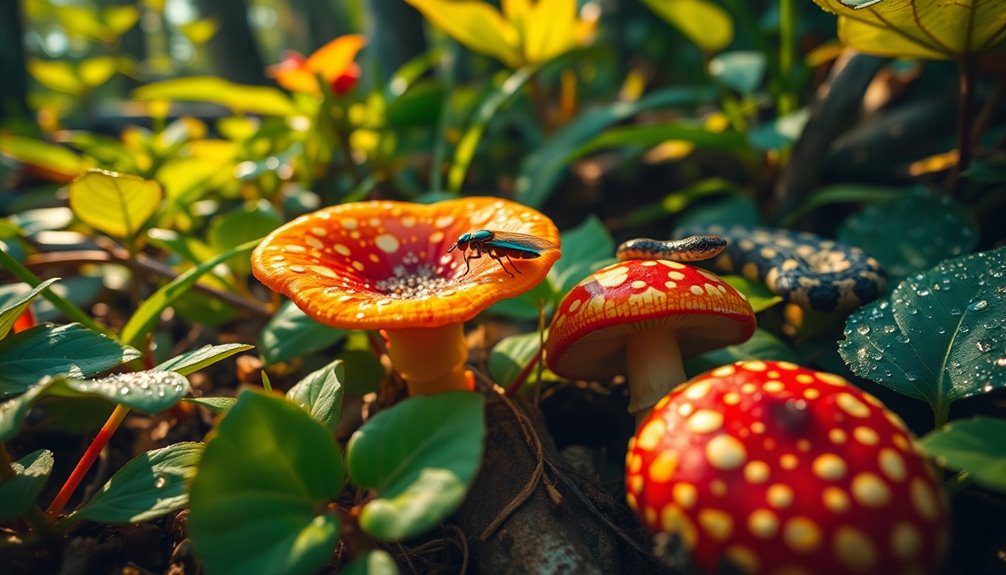
While exploring nature, it's crucial to recognize the dangers posed by toxic plants and animals that can quickly turn a pleasant adventure into a harmful experience.
Familiarize yourself with toxic plants like poison ivy, poison oak, and poison sumac, which contain urushiol, causing severe skin rashes upon contact. Be cautious around pokeweed; its berries are highly toxic and can lead to respiratory failure if ingested.
Also, watch for deadly mushrooms like the Amanita phalloides, which can result in liver failure.
In the animal kingdom, avoid the Eastern diamondback rattlesnake, whose venom can cause serious injury, and steer clear of the blue-ringed octopus, as its venom can lead to paralysis and respiratory failure.
Stay alert and safe!
Poisonous Plants in Foraging
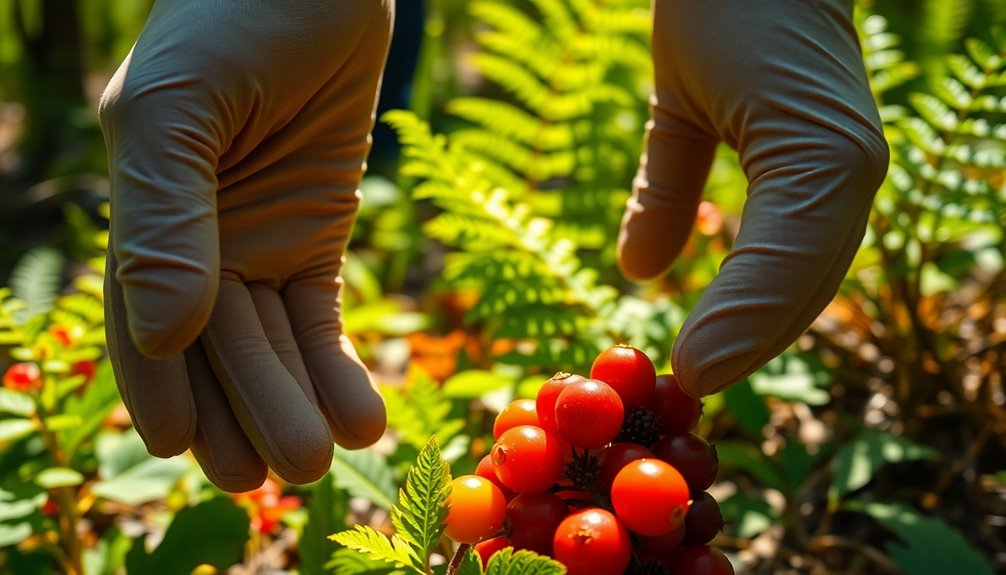
When you're foraging, knowing how to spot poisonous plants is essential to prevent serious health risks.
Many edible plants have dangerous look-alikes that could lead to severe consequences.
Always ensure you've positively identified what you're picking to keep yourself and local wildlife safe.
Preventing Serious Health Risks
Foraging in the wild demands careful attention to detail, especially regarding the plants you encounter. Remember, some toxic plants closely resemble safe ones, like hemlock, which can be deadly if misidentified.
Always consult an expert before consuming wild mushrooms; many can cause severe poisoning or even death. Familiarize yourself with local flora using reliable field guides or apps to differentiate between safe and poisonous plants.
Understand symptoms of poisoning, such as gastrointestinal distress or respiratory failure, so you can act quickly if needed. It's crucial to wash your hands thoroughly after handling wild plants to avoid accidental ingestion of toxins. Additionally, be aware that certain foods like toxic foods for birds can also pose risks to humans and pets if ingested.
Educate others in your group about these risks and know when to contact Poison Control for immediate assistance.
Local Wildlife Hazards
Understanding local wildlife hazards is crucial for safe foraging. Many wild plants, like poison ivy, hemlock, and pokeweed, can cause severe reactions if touched or ingested. You must correctly identify them to avoid issues.
Wild mushrooms pose a significant risk too; many toxic varieties closely resemble edible ones, and misidentification can lead to serious illness or even death. When foraging for berries, remember that some, like elderberries and pokeberries, can be toxic when unripe or eaten in large quantities.
Always consult a reliable field guide or an expert before consuming any wild plants, as even those that seem safe might cause gastrointestinal distress or allergic reactions. Awareness of specific seasons and habitats can help you steer clear of these hazards.
Emergency Contact Information
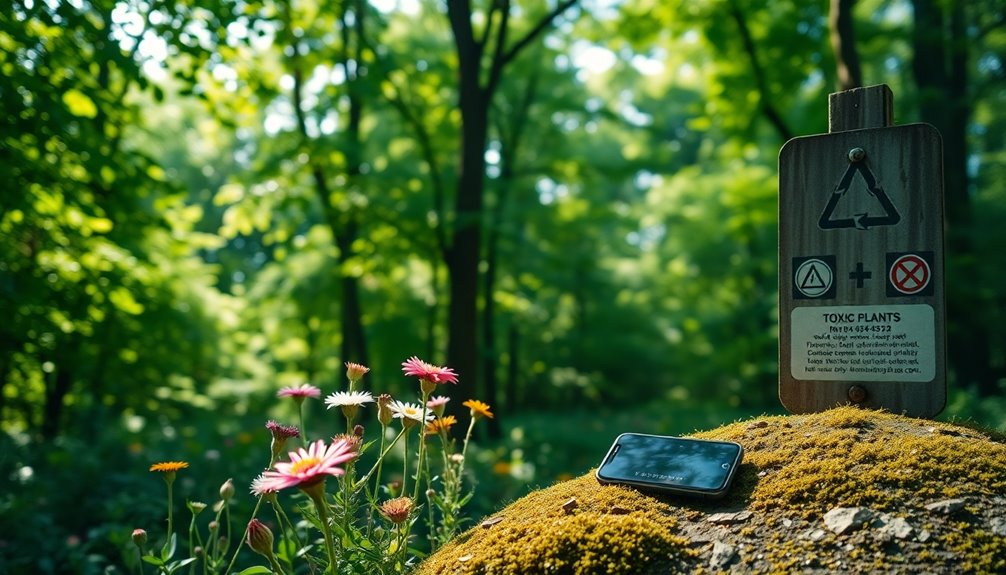
Maintaining easy access to emergency contact information is essential while exploring the wild.
In case you encounter poisoning or exposure to toxic substances, immediately contact the National Poison Help Hotline at 1-800-222-1222 for expert advice.
Poison Control Centers in the U.S. handle millions of calls each year, underlining the need for having emergency contact information readily available.
Keep local poison control numbers, like the Washington Poison Center at (800) 222-1222, close to your phone or in your emergency kit.
Always remember that immediate medical advice is crucial when dealing with poisoning incidents.
Don't hesitate to reach out for help if you suspect exposure to any toxic substances; it could make a significant difference in your safety.
Safety Gear Recommendations
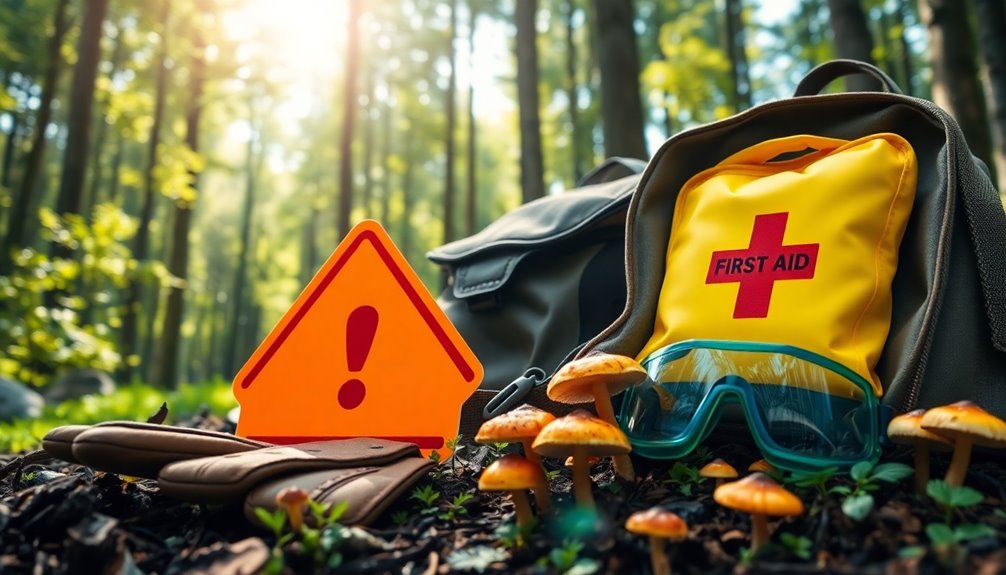
When exploring the wild, wearing the right safety gear can significantly reduce your risk of exposure to toxic substances.
Start by always wearing gloves when handling wild plants and mushrooms; this prevents skin absorption of potential toxins. Protective eyewear is essential when applying pesticides or chemicals outdoors, shielding your eyes from harmful splashes.
Opt for long sleeves and durable pants to minimize skin exposure to irritants like poison ivy. If you're dealing with chemicals or materials that release harmful dust, consider wearing a mask for extra protection.
Lastly, equip yourself with a first aid kit that includes activated charcoal, a useful item in case of accidental ingestion of non-corrosive poisons.
These prevention tips can keep you safer during your outdoor adventures.
Essential Outdoor Safety Tips
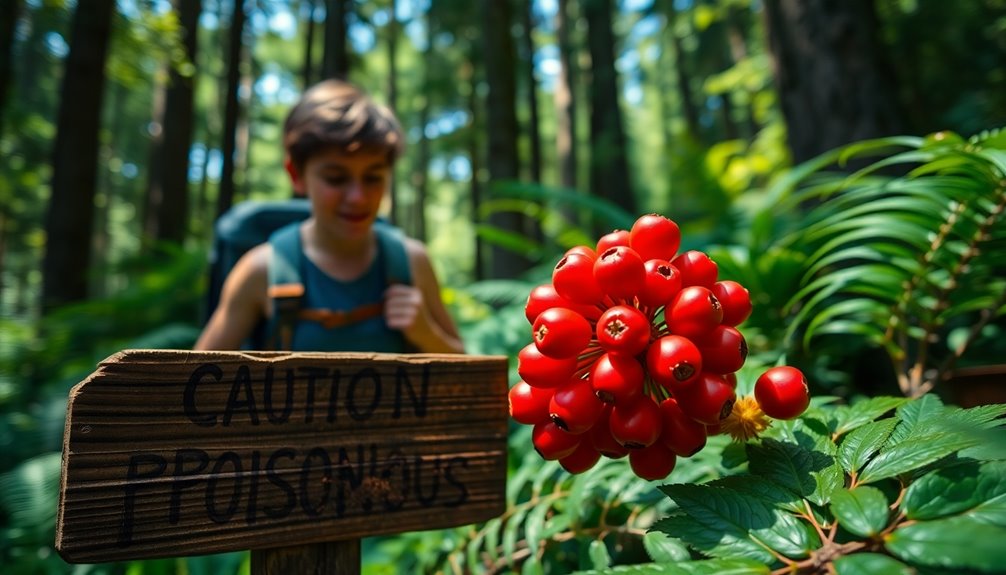
Outdoor safety is crucial for enjoying your adventures without mishaps.
Start by familiarizing yourself with local poisonous plants like poison ivy and hemlock to avoid skin contact and ingestion. When it comes to wild mushrooms, many are toxic, so it's best not to forage unless you're trained.
During picnics or camping, don't leave perishable foods out for more than two hours to prevent foodborne illnesses. Always carry a basic first aid kit that includes treatments for allergic reactions and skin irritations.
Lastly, educate yourself and your companions about the signs of poisoning, and keep the poison control number (1-800-222-1222) handy for emergencies. Staying informed can make all the difference in ensuring a safe outdoor experience. Additionally, consider packing a portable camping toilet to maintain hygiene and minimize exposure to harmful substances in the wild.
Identifying Poisonous Species Quickly
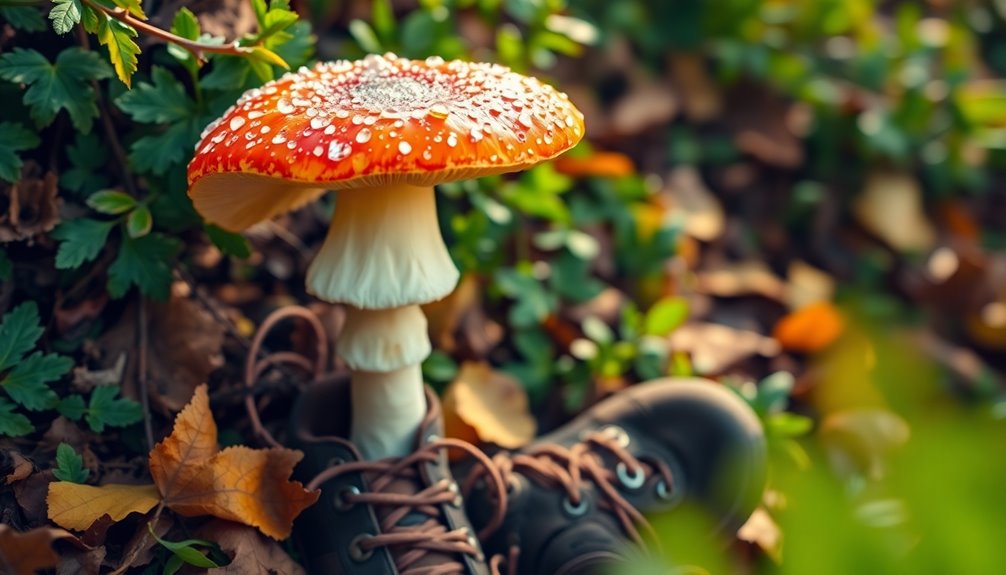
When you're exploring the outdoors, knowing how to quickly identify poisonous species is crucial for your safety.
Familiarizing yourself with common toxic plants and mushrooms can prevent accidents and wildlife poisoning risks.
Make use of field guides or mobile apps to help you recognize these dangers on your adventures.
Wildlife Poisoning Risks
Navigating the wilderness requires keen awareness of your surroundings, especially when it comes to identifying poisonous species. Many wild mushrooms are potentially dangerous, containing toxic compounds that can cause severe illness or even death.
Plants like poison ivy, poison oak, and poison sumac can trigger allergic reactions, leading to uncomfortable rashes. Certain berries, such as pokeberries, look harmless but are toxic, especially to children.
Additionally, some wildlife, including snakes and insects, may carry venom that poses serious risks. To stay safe, educate yourself on local flora and fauna, as many toxic species can easily be mistaken for non-toxic ones.
Proper Identification Techniques
Identifying poisonous species quickly is crucial for your safety in the wild. To do this effectively, make sure you familiarize yourself with common poisonous plants like poison ivy, poison oak, and hemlock.
Study clear images and descriptions to aid in quick identification. Utilize field guides or mobile apps tailored for wild plants and mushrooms, which often highlight toxic species.
Learn the distinguishing features of edible versus poisonous mushrooms by examining gills, color, and spore print characteristics. Attend local workshops or nature walks led by experts to gain hands-on experience.
Always err on the side of caution; avoid consuming any wild plants or mushrooms unless you're absolutely certain of their safety, as many poisonous species closely resemble edible ones.
Survivor Stories of Poisoning
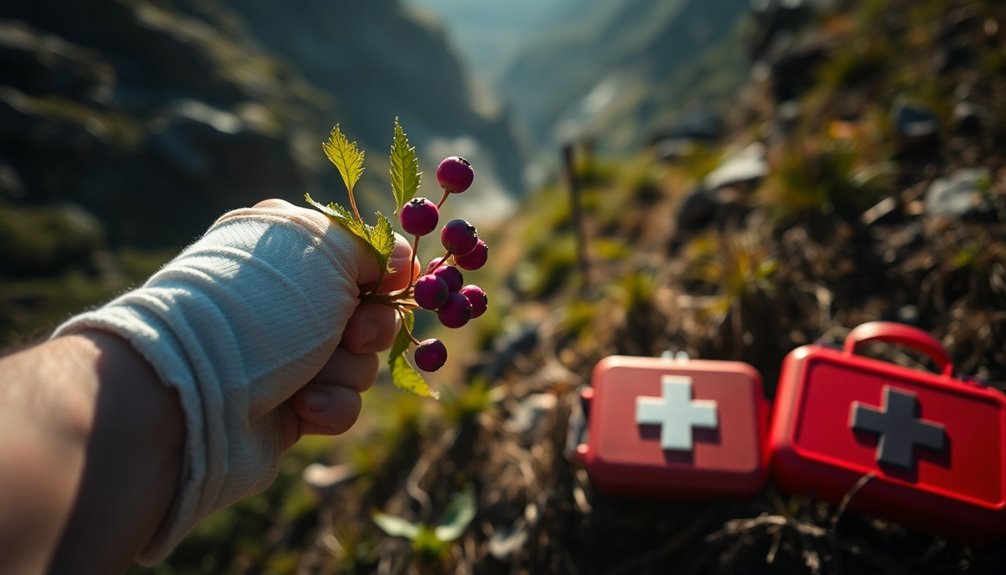
Survivors of poisoning often share harrowing tales that shed light on the dangers lurking in the wild. One story involves a hiker who mistook toxic mushrooms for safe ones, leading to severe liver damage. Others recount the frightening experiences of synthetic cannabinoid use, where unpredictable effects resulted in seizures and psychosis. Many survivors credit their recoveries to quick intervention from Poison Control Centers, highlighting the crucial need for expert help. In alcohol poisoning cases, bystanders played a lifesaving role by recognizing symptoms and placing victims in the recovery position. Additionally, awareness efforts have reduced incidents of poisoning from household chemicals, like lighter fluid, as survivors share their experiences to educate others about safe practices and storage. Understanding antimicrobial properties can also play a role in preventing infections from wounds caused by toxic plants.
Conclusion
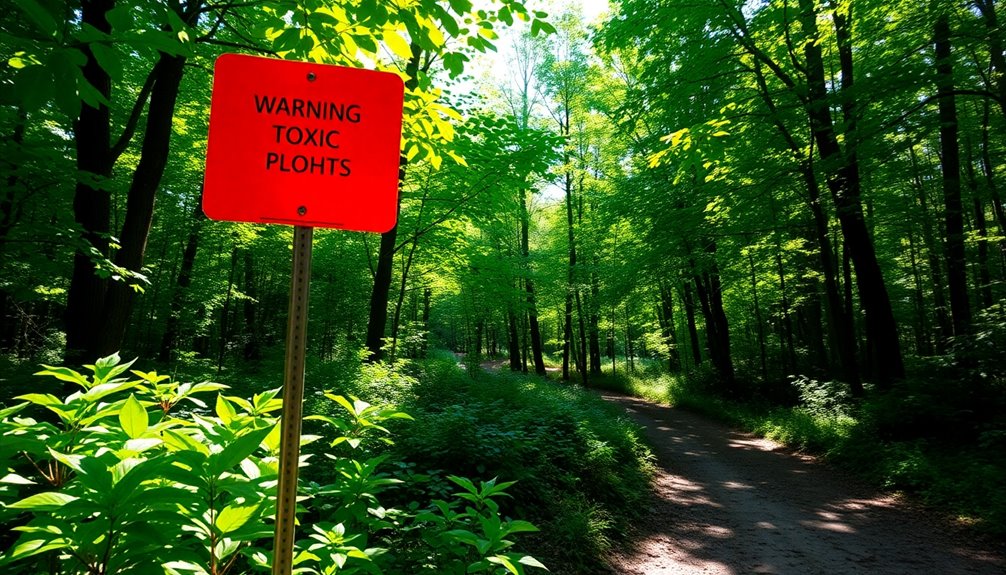
How can you ensure your safety while exploring the wild? Staying informed is key.
Be aware of poisonous plants like poison ivy and hemlock, as well as local wildlife hazards such as snakes and insects. Understanding the symptoms of bites, stings, and allergic reactions can save lives.
Always carry a comprehensive first aid kit, equipped with treatments for poison exposure. When it comes to wild mushrooms, only consume those from trusted sources, as many varieties can be toxic.
Lastly, keep the Poison Control Center's number (1-800-222-1222) handy for emergencies.
Additional Resources
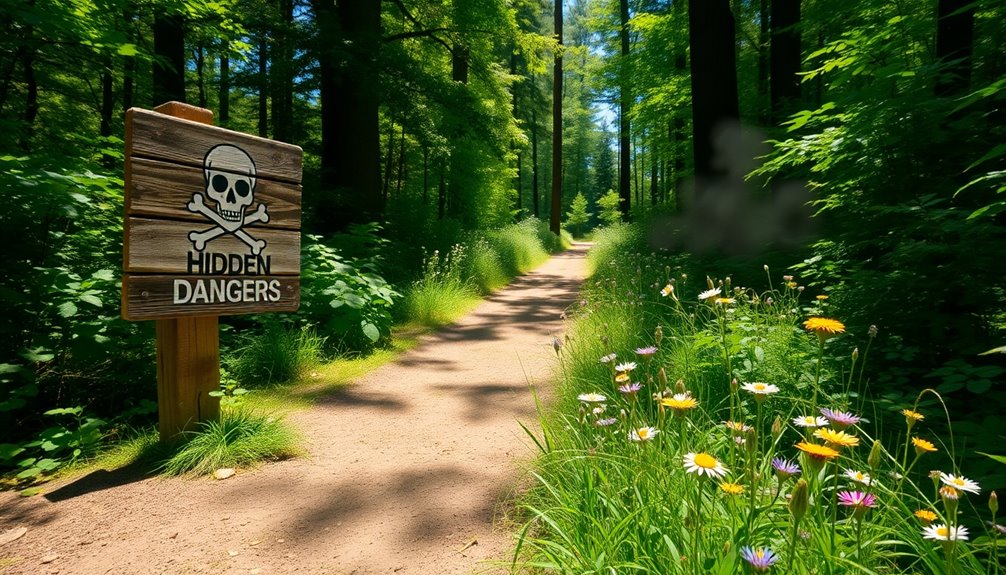
When you're out in the wild, knowing where to find reliable information can be a lifesaver. The Washington Poison Center offers free, expert advice for poison exposure at (800) 222-1222. If you ever suspect someone's been exposed to something toxic, like paint thinner, don't hesitate to call.
The National Poison Help Hotline is another great resource, receiving millions of calls each year, especially during seasonal hazards like poisonous mushrooms in the fall. For on-the-go information, download the webPOISONCONTROL app, which helps with poison identification and treatment guidance.
Additionally, subscribing to updates from poison prevention initiatives can keep you informed about environmental risks and safety practices, ensuring you're always prepared in both household and wild settings.
Frequently Asked Questions
What Precautions Should We Take for Safety Against Poisoning?
When it comes to safety against poisoning, you should always educate yourself about potential hazards in your environment.
Carry a first-aid kit stocked with activated charcoal and poison control numbers. Avoid consuming any unfamiliar plants or mushrooms unless you're completely sure they're safe.
Stay alert to seasonal risks, and make sure to store food properly, limiting exposure to harmful bacteria.
Being proactive will help ensure your outdoor adventures remain safe and enjoyable.
What Can Save You From Poison?
To save yourself from poison, you need to stay informed and prepared. Familiarize yourself with local plants and their potential dangers, and always carry a field guide or app for quick identification.
If you suspect poisoning, recognize the symptoms like nausea or difficulty breathing, and act fast. Keep emergency contacts handy, and most importantly, avoid consuming anything you're not sure about.
Your awareness and quick action can make all the difference in a dangerous situation.
How Can We Prevent Poisoning in Animals?
To prevent poisoning in animals, you need to securely store all household chemicals and medications out of their reach.
Educate yourself about common toxic foods and plants, like chocolate and lilies.
Monitor your yard for hazardous substances, such as pesticides.
Look out for signs of poisoning, like vomiting or lethargy, and consult a vet immediately if you notice any symptoms.
Keeping your pets safe means being proactive and informed about potential dangers.
Which of the Following Is a Precaution for Preventing Poisoning?
To prevent poisoning, you should always educate yourself on the appearance of toxic substances. Familiarize yourself with plants and mushrooms that could be harmful.
When handling unfamiliar species, wear gloves to avoid skin irritation. Make sure to securely store food and never leave it exposed for too long.
Lastly, if you're unsure about the safety of something, don't consume it. Always prioritize safety and trust your instincts when in doubt.

